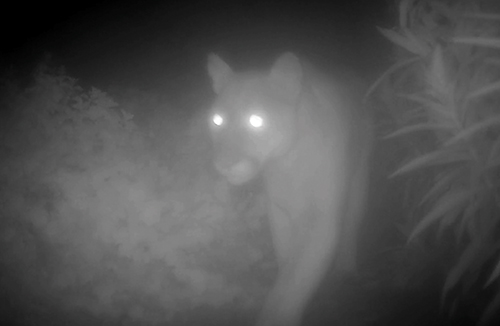A mountain lion seen on a trail camera in Los Osos near the El Moro Elfin Forest. Photo by Gene ‘Skip’ Rotstein
A mountain lion was recently spotted on a trail camera in the front yard of a home in Los Osos.
The feline, which can be 60 to180 pounds and up to 8-feet long, was spotted in the 1100 block 8th St., about a block from the El Moro Elfin Forest Nature Preserve.
“A game trail runs along the water’s edge from the Preserve and through my front yard. So any animals I see can be assumed to also spend time in the Preserve,” Gene “Skip” Rotstein, a retired high school biology teacher and board member of the Friends of El Moro Elfin Forest, told Estero Bay News.
The mountain lion’s glowing eyes are the first to come into view on the recording from March 27 at about 2:30 in the morning. Then it slowly walks by seemingly looking at the camera.
“I have never seen a mountain lion,” Rotstein said. “This is the first time I have captured one on video. I describe the mountain lion video sighting as my Holy Grail moment. I am thrilled to know such an important member of our ecosystem is alive and, I hope, well. Mountain Lions travel tremendous distances and might have been back in Montana de Oro by dawn.”
Freddy Otte, a biologist for the City of San Luis Obispo, issued a news release earlier this year following a report of a mountain lion grabbing a leashed dog in the Prefumo Creek area and taking off with it, dragging the owner in the process. The dog died in the incident, and the lion was successfully trapped, fitted with a GPS tracker and relocated outside of the city.
“It’s important to remember that we live in a region that is home to a variety of wildlife, including mountain lions,” Otte said. “These majestic creatures have been roaming these hills and valleys for centuries, and while they are a natural part of our environment, it’s understandable that the recent sightings and attack on a pet may be causing some concern. Mountain lion attacks on humans are extremely rare, and it’s even rarer for them to occur in urban areas. In fact, according to the California Department of Fish and Wildlife, there have been only 16 verified mountain lion attacks on humans in California since 1890.”
That said, precautions should still be taken. If folks encounter a mountain lion, “Don’t run,” County Parks Superintendent Don Melin told EBN. “Running can trigger a prey reflex and could result in the animal chasing you. Stay calm. It’s best to stand your ground, stay upright (don’t crouch), and keep eye contact. Try to appear larger. Wave your pack around and yell. Back away slowly. Lions don’t want to fight; they are looking for food. It is important to note that small children should be supervised when playing in any wilderness area. A lion could mistake a small child for prey.”
Additionally, do not feed any wildlife, to avoid attracting predators to populated areas. Keep your pets inside at night, as mountain lions are known to prey on small animals like rabbits, cats, and dogs. Secure your garbage cans, bird feeders, and compost bins at night to prevent attracting wildlife to your home or neighborhood.
“In the rural parts of our county that back up to forest and woodland areas, there is the possibility that a lion will pass through at some point,” Melin said. “Lions have large territories — males up to 150 square miles, so they are always on the move.”
Signs that a mountain lion might be in the area, according to the U.S. Department of Agriculture Forest Service website, include: large tracks (3-5 inches wide) without claw marks; food caches, where a kill has been partially eaten and then covered with brush and dirt; scrapes in soft dirt or leaf litter, and claw marked trees and logs.
The mountain lion, known as P22, became an unlikely celebrity of sorts in Los Angeles. For the curious, the P stands for puma, while the number corresponds to the individual cat being tracked by National Park Service biologists. Residents of the area became fans when the big cat was caught on film in Griffith Park about a decade ago. After his health was noticeable declining, wildlife officials determined that he had been hit by a car and made the difficult decision to euthanize the big cat last December. People across the country mourned his death with many gathering at Griffith Park to say goodbye.
It remains to be seen if P-22’s notoriety will help future generations of mountain lions by raising awareness or if the celebrity status takes away from the fact that it is a wild animal that can be dangerous.
“I think people need to understand that these animals were here long before humans and have adapted to our gradual presence in their ecosystem,” Melin said. “Unfortunately, with their continued loss of habitat, there will be increased interaction with humans. We need to take precautions to protect ourselves as well as our pets, and to protect the lions as well. It’s exceedingly rare that a human is injured by one of these animals. ”
For now, Rotstein will continue his hobby of so-called camera trapping that began as an at home activity during COVID using five Browning trail cameras.
Other animals captured include mice, woodrats, rabbits, opossums, raccoons, coyotes, a barn owl (on the ground), a great horned owl (on the ground), deer, quail, a mallard duck, crows, innumerable small birds, a pair of grey foxes, a red fox, and a long tailed weasel.
The videos for all the mammals, owls, and mallards have been curated and uploaded to YouTube at SkipRotstein3535.
Rotstein sent the mountain lion video to County Parks Ranger and a photo was uploaded to CA Fish and Wildlife website.




